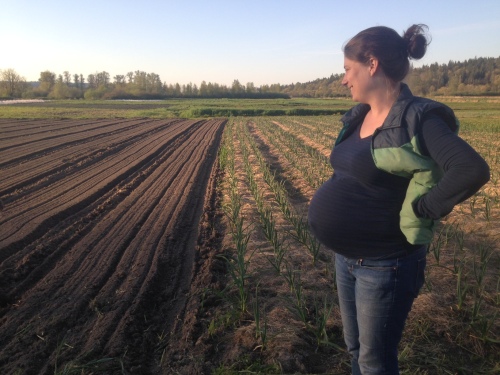Just like every other spring we’ve experienced since we started Local Roots Farm eight seasons ago, this one has been quite unusual. This March, we endured the wettest month in the PNW since November 2006. Usually, around here, November through January are when it rains the most, and the most often. Lately, we’ve noticed that the winters have been drier than normal and spring wetter. In addition to the unfortunate effect this has on the quality of the skiing, it also makes getting our year started a bit more difficult. We end every year planting cover crops and we begin each spring turning those cover crops into the soil. But when the ground is wet, you can’t work it…. and so throughout March, we mostly waited.
Thankfully, the weather gods were kind enough to us to provide a few opportunities to start turning fields of cover crops into fields of beds ready for seeds and transplants. We have adopted a new regime for taking a field from cover crop to seed bed that we are very pleased with. After we flail mow, we are using a Perfecta II field cultivator as our initial tillage tool. We like the fact that you can work up a field pretty quickly with it, and the action of the tool seems to encourage drying. In prior years we’ve tried spading (slow and surprisingly ineffective), disking (neither of our disks is heavy enough to do an adequate job), and tilling (slow and bad for the soil). The results from the Perfecta have been great. It slices cover crops just below the soil, killing most of the plants, and it fluffs and aerates the top few inches, promoting drying.
We follow the Perfecta with the spader. The spader works wonders when spading a field that’s already fairly clean. We like the spader because it works well when soil is damp, doesn’t require much horsepower or traction, tills deep, uncompacts the tire tracks, and doesn’t leave a hardpan below its working depth. The major drawback to the spader is that it’s very slow. 1 mph slow. It takes nearly three hours to spade an acre. But for early-season tillage, it’s probably the best tool out there because you can work a field earlier with the spader than most any other tool.
For those of you following along at home, you know we had an exceptionally cold winter that killed off nearly all of our overwintering plants, leaving us with very little early season produce to sell. We have planted nearly all of our greenhouses to fast-growing arugula, radishes, turnips, and baby lettuce…. and 100% of what we’ve been harvesting has been going to our favorite restaurants around Seattle.
When, then, will we return to the farmers markets? A good question. We have just started harvesting from the first succession of direct-seeded beds planted outdoors. We are just beginning to see the first trickle of that bounty starting to flow in. We also have a good amount of lettuce and kale lying in wait, ready for us to begin markets again.
If this were an ordinary year, we would have probably started vending at the Broadway Market already… but it’s not. Siri and I are expecting our second child in less than a week and we’ve decided to hold off on farmers markets until we’ve gotten over that hurdle. Right now, we are aiming for May 11th to be our first market of the year. Come see us, and say hello to the newest addition to the farm!





Siri, you are looking beautiful…fully with child. By ow the baby might have even been born. Sandy said she was out at the farm, awaiting its arrival. We look forward to returning home about July 1 and joining the CSA once again. Your veggies are the best!
Congrats, Jason & Siri! What wonderful news! We wish you the best as you transition to two kids and the busy season. May Felix and the new one be very kind to you 🙂
Nice blog. Very interesting to us non farmers. Siri you look beautiful!! Have an easy delivery. Mino and Nancy